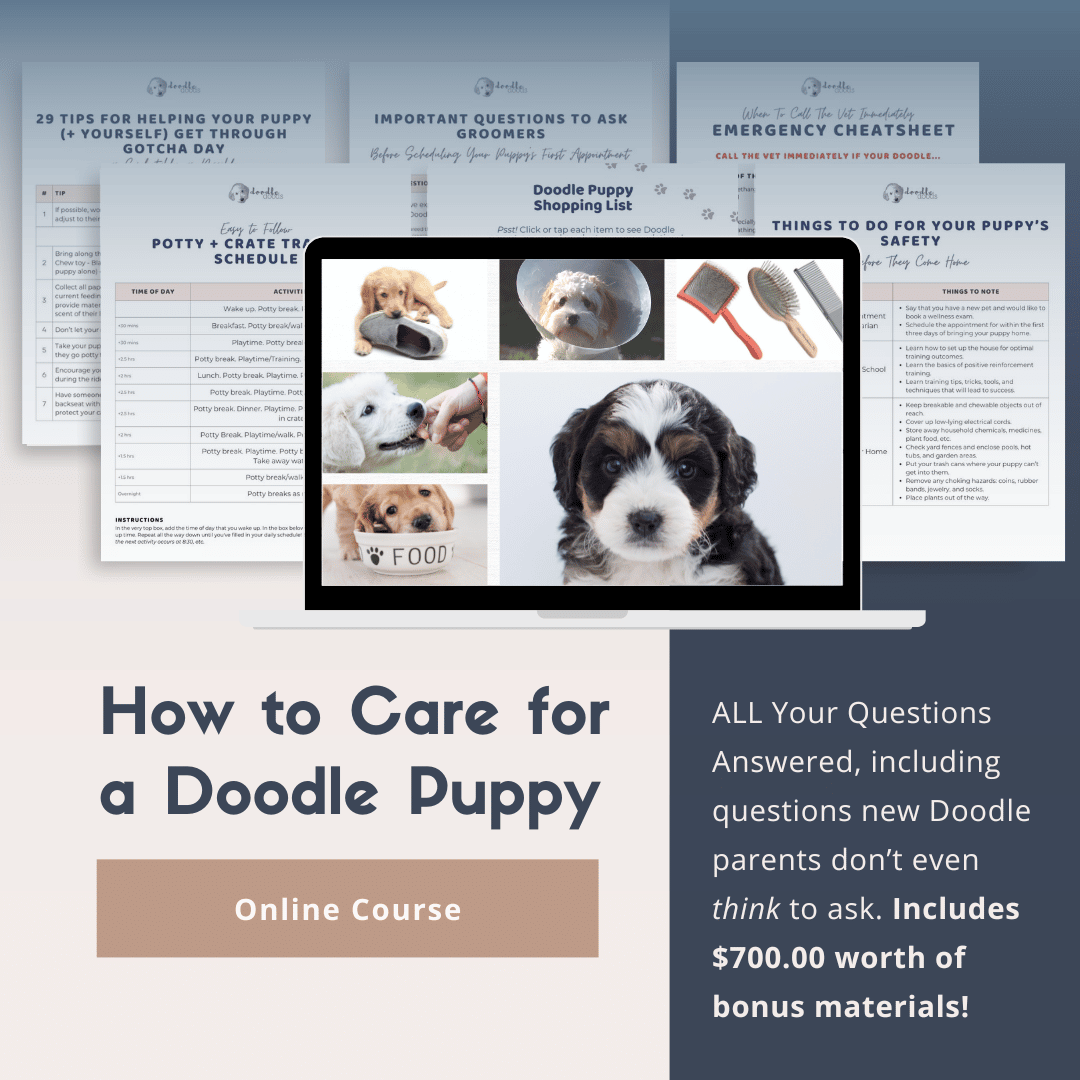Puppyhood is filled with many precious moments as well as challenging periods until they reach adulthood. In this article, we’re going to cover all the puppy growth stages from birth to their first birthday. You’ll also be able to see first-hand how it looks with the help of puppy growth week by week pictures. Let’s dive in!
Puppy Stages Of Development Week By Week
What are the growth stages of a puppy? When do puppies grow the most?
If you’ve adopted or are planning to adopt your special little fur baby, you’re likely wondering how the first year is going to pan out. In the following chapters, we’ll cover all the puppy stages in the first year. This is a time where your pup needs your undivided attention and care, so they’ll grow into healthy, happy, well-rounded, and well-behaved adults.
Here we go…
Puppy Growth Stages: 0-4 Weeks
The first weeks from your puppy’s birth are obviously going to be a very tender, transformative time for the puppy. In fact, the first 4 weeks can be broken up to: neonatal period (0-2 weeks) and transitional period (2-4 weeks). Around 3 weeks of age, dogs enter their socialization period, which is one of the most important puppy growth stages.
Neonatal Period, Weeks 0-2
During the neonatal period from weeks 0 to 2, puppies are neurologically immature, blind, and deaf. They fully rely on their mother for everything. Although they can touch and taste at birth, that’s pretty much all they’ll comprehend at this stage. Even though they’re born covered in fur, they won’t be able to regulate their own body temperature. For this reason, they need their mama to keep them warm. During the first week, only the puppy’s front feet are strong, so they’ll only be able to pull themselves towards mama. But by week 2, their forelegs will get noticeably stronger. During this puppy growth stage, dogs sleep for the majority of the time.
Transitional Period, Weeks 3-4
During the transitional period from 3 to 4 weeks, puppies start to develop a little bit more independence. They start regulating their body temperature, cut their milk teeth, and start eating puppy food. Their eyes open up, they learn how to stand up, sit, and start taking their first steps. They develop a sense of smell and hearing, and start responding to sounds. Puppies now start learning some simple social skills, such as tail wagging, growling, and pawing. They’ll also start developing and showing their personality, gain confidence, and learn appropriate social behavior with other dogs.
Puppy Growth Stages: 4-12 Weeks
Weeks 4-8
Puppy development by weeks 4 to 12 is considered the socialization period. By playing with their siblings, they learn crucial social skills and they can now be exposed to a variety of people, new surroundings, environments, and stimuli. It’s crucial to nail the socialization period, as this will determine the puppy’s lifelong behaviors.
By 5 weeks, pups will be familiar with their surroundings and start really participating in playtime. They’ll run and play, and start wrestling with their siblings and playing with toys. They can bark and growl and learn social cues from their siblings. On the other hand, during this time, they may start to enter the first fear period and show fearfulness at strange sights and sounds.
Usually, by the end of week 6, puppies are fully weaned and can now eat puppy food five to six times a day. After weaning, they should also receive their first vaccinations for distemper, parainfluenza, and measles. Around the 7 week mark, breeders often start house-training puppies. At the end of their second month, 8 week old puppies are independent and ready to go home.
Weeks 8-12
Now that your little fur baby is coming home at around 8 weeks old, it’s crucial you continue with proper socialization and training that the breeder has started. Introduce your pup to people of all ages, appearances, and genders. Make sure your puppy gets used to seeing people in all sorts of attire like hats, sunglasses, and coats. This is an important puppy growth stage, as it will form lifelong behavioral patterns. What’s more, from weeks 8 to 10, puppies go through a normal fear period, which you can ease with positive reinforcement and training.
In terms of a puppy’s physical development, by week 8, we can expect puppies to sleep around 18-20 hours a day to support their rapid puppy growth spurts. However, 8-12 week old puppies won’t have good bladder control, so be prepared for some accidents around the house. As they grow, they’ll need more and more food. Make sure you feed your pup an appropriate amount of food, around 3-4 times a day. Here’s a helpful guide on this topic.
Although you might want to introduce your puppy to other dogs and bring them outside to public places, you should refrain from doing that until they’re fully vaccinated around 16 weeks old. Here’s a guide to the puppy vaccination schedule.
Puppy Growth Stages: 12-20 Weeks
Your puppy’s development by week 12 has been staggering. They go through many physical and behavioral changes and experience rapid puppy growth spurts. By the end of their third month, puppies already resemble miniature versions of their adult self and have a less puppy-like look.
At 3 months old, your puppy should have pretty good control over their bladder and bowel movements. By now they’ll usually be able to sleep through the night without potty breaks. Nevertheless, keep up with the potty training and your pup should make great strides towards becoming fully house trained.
By week 12, puppies usually have started to understand ‘ranking’ in terms of submission and dominance. They start to understand when they need to go potty, and also how to communicate and learn from the pack members. 3 month old pups are super receptive to training, so make sure you keep up with obedience training, house training, and crate training.
From 16 weeks and onwards, puppies still grow at a fast rate and keep putting on weight and growing in height. By now, medium to large dogs should be at about half their adult height. Smaller pups are likely to have passed half their adult weight as well. As they get older, they need more food to support their growth and development. Additionally, by 16 weeks old, their teething should slow down considerably.
Check out our Doodle size guides for specific growth patterns for your Doodle!
At around 16-20 weeks of age, your puppy is likely fully vaccinated and you can now take them out to public places and dog parks to meet with new friends and discover all the beauty that the world has to offer.
Puppy Growth Stages: 20-28 Weeks
Puppy development by week 20 has likely put an end to teething. A 20-week old pup might still chew and bite, but you can expect this to pass very soon. Around this time, puppies usually start nearing their sexual maturity, but they still continue growing in height and weight. It’s also time to start thinking about spaying or neutering your puppy. You should consult with your veterinarian to plan ahead in time.
By 5-6 months old, mini and medium Doodles will reach about half their adult weight. Again, as they continue growing, they need more and more food. But as they’ve now reached about half their adult size, they’ve usually developed increased stamina and you can take them for 20-minute walkies each day.
In addition to that, pups are now becoming less dependent and feel more comfortable wandering around the house on their own. They become more curious, confident, and develop their sense of self.
By 6 months old, puppies have now experienced their most rapid growth spurts and enter their adolescence period. Dogs at this age tend to act like human teenagers with their rebellious, testing, and destructive behaviors. At the same time, it’s likely they experience their Fear Imprint Period, which sees them becoming scared of simple things like shadows, fire hydrants, or even couch pillows.
In terms of their size, smaller Doodles are almost finished growing, but they’ll likely continue to gain a few more pounds and fill out over the next few months. Larger Doodles are at about half their adult weight, so they’ll take several more months to reach full maturity. Regardless of their size, Doodles at this age may look a bit funny – they look almost like adults, but not quite, and still act as puppies. What a precious time!
Puppy Growth Stages: 28-36 Weeks
Puppy development by week 28 sees them firmly in the hellion stage. They might become a little bit annoying, but nevertheless adorable. They’ve got loads of energy and they tend to challenge their owners. You can help them express all the pent up energy with lots of playtime and exercise to keep them entertained. More often than not, they’ll ignore the many cues they actually know and act like they’ve forgotten all of their previous training. Stay firm and consistent.
If your female puppy hasn’t already, it’s likely that they’ll now go into heat. For this reason, it’s especially important you consider spaying, as they can easily get pregnant. The same goes for male pups – although they can’t get pregnant, unneutered dogs usually form the habit of marking with urine and trying to escape the house to mate.
A 7 month old puppy is likely still growing, depending on their size. However, smaller Doodles can finish growing as early as 7.5 months old. Around this time, you can also start adjusting your puppy to 2 meals a day. Of course, you should also adjust their food quantities as they grow older. Remember, the larger the pup, the more food they need.
By 8 months old, puppies are full-fledged adolescents and getting nearer to adulthood. Ages of 7 and 8 months are fairly similar, but the puppy will continue to grow in height and weight. Many Doodles will now start nearing their adult height and smaller pups have reached their full adult size. If your 8-month old puppy has major issues with house training, you might want to consult with your veterinarian to get to the root of the issue. In addition to that, by 8 months old, your pup is likely to have all of its adult coat.
Puppy Growth Stages: 36-44 Weeks
In terms of their behavioral development, puppies are still in their adolescent stage, which may last up to 18 months old! Nonetheless, give your pup all the love and care it needs and enjoy the last stages of puppyhood. Many Doodles are now reaching adulthood and soon they’ll be fully matured. Although it might seem like they aren’t changing much in this time period, your pup is still learning and growing every single day.
As we mentioned, it’s highly likely that your puppy is still showing testing behaviors and wanting to rebel against everything you’ve taught them. Never punish your pup, but also don’t reward their undesired behaviors or reactions. Instead, guide your pup with positive reinforcement and firm training techniques. If your puppy is becoming destructive, it’s your cue to give them plenty of exercise and playtime they need.
Additionally, some pups go through their Fear Imprint Stage at this age. It usually occurs sometime between 6 and 18 months old. A general rule of thumb is that smaller dogs experience it at a younger age and larger pups at a slightly older age. Although it might seem odd that your puppy is suddenly afraid of usual household objects or sights and sounds that they weren’t before, bear with them. Let your pup investigate the strange, scary objects in their own time and give them lots of praise for showing curiosity.
Puppy Growth Stages: 44-52 Weeks
Congratulations! Puppy stages of development are now nearing the end, as most Doodles tend to finish growing and reach full maturity at this age. Although still ‘teenagers’, your puppy likely looks like an adult and wants to behave like one. Their willfulness is unmatched and they’ll want to do whatever it is that’s on their mind.
In terms of their physical development, most puppies have now finished growing. Larger Doodles might still continue gaining weight and filling out, but they’ve most likely reached their adult height. If they do continue growing, the changes aren’t as noticeable as they were a few months ago.
On the other hand, their adolescent period is likely going to last at least 6 more months and up to 18 more months for larger pups. But as you’ve already gotten a hang of it and survived the more tumultuous months, it’s going to be *almost* smooth sailing from now on.
In addition to that, as they’ve now reached adulthood, you should start adjusting them to recommended adult dog food formulas. Puppy formulas are higher in calories to support their growing, demanding bodies. So, switching it up is usually recommended. However, make sure your pup has enough time to adjust, as dogs, especially Doodles, have sensitive stomachs and switching their diets too quickly can result in gastrointestinal issues.
Moreover, around their first birthday, it’s time you schedule your puppy’s first annual vet exam. Your veterinarian is going to examine your pup from the top of its head to the tip of its tail. They’ll go over your pup’s vaccination records and evaluate your dog’s diet and growth.

Puppy Growth Stages: FAQ
What Age Do Puppies Have Growth Spurts?
Puppy growth spurts usually occur up until 6 months old. By that time, smaller pups have already finished growing or are nearing their adult size, while larger pups will now slow down on their growth and gain weight and height at a more stable, slower pace.
What Months Do Puppies Grow The Most?
The most rapid puppy growth spurts happen from birth up until 6 months old. That’s around the time they’ve reached about 50% of their adult weight. After that, their growth will start to gradually slow down until it plateaus at their full adult size between 1 and 2 years old.
Our Doodle Puppy Growth Tracker is a great tool for keeping track of your puppy’s growth up to 100 weeks of age.
Do Puppies Sleep More During Growth Spurts?
Dogs can, in fact, sleep more during their puppy growth spurts. As their body is trying to keep up with all the changes and developments, they need to rest and recharge during all of these changes. Of course, if you’re worried that your puppy is sleeping too much, always contact your veterinarian to rule out any underlying health conditions.
What Is The Hardest Puppy Stage?
The neonatal period from 0 to 2 weeks old is one of the hardest puppy growth stages. During that time, puppies are very helpless, practically blind and deaf, and fully rely on their mama. In addition to that, the adolescence period from 6 to 18 months can also be a very tricky time, as puppies now tend to test their human parents. They pretty much act like teenagers and even pretend to have forgotten all of their training. But don’t worry, this difficult puppy growth stage will pass. As long as you stay firm and consistent with the habits you’ve taught your pup.
How Can I Tell If My Puppy Is Having A Growth Spurt?
Naturally, one of the easiest telltale signs of your puppy having a growth spurt is them growing super fast. Additionally, in those puppy stages of development, you might notice excessive chewing habits and the shedding of their puppy fur transitioning into adult fur.
To conclude, puppy growing stages can be somewhat challenging, but so much more rewarding in the long run. In those 52 weeks, you’ll have the chance to teach your puppy essential skills, training, and bond with them on a deeper level. Hopefully, you’ve learned many interesting facts and useful tips from this guide, and that our puppy growth week by week pictures have given you a good idea as to what to expect in the upcoming months.
Learn How to Care for Your Doodle Puppy!

Perfect for first-time Doodle parents, get ALL your questions answered, including questions new Doodle parents don’t even think to ask.
Plus, get $700 worth of Bonus Materials for FREE, including:- Doodle Parenthood Community and Support Group ($190 value)
- Doodle Puppy Growth Tracker ($20 value)
- EMERGENCY Cheatsheet: When To Call The Vet Immediately ($50 value)
- HELP! Button ($145 value)
- And SO MUCH MORE!
The information on this page is for informational purposes only. It is not intended to be a substitute for qualified professional veterinary advice, diagnosis, or treatment. Always seek the advice of your veterinarian or other qualified animal health provider with any questions you may have.








